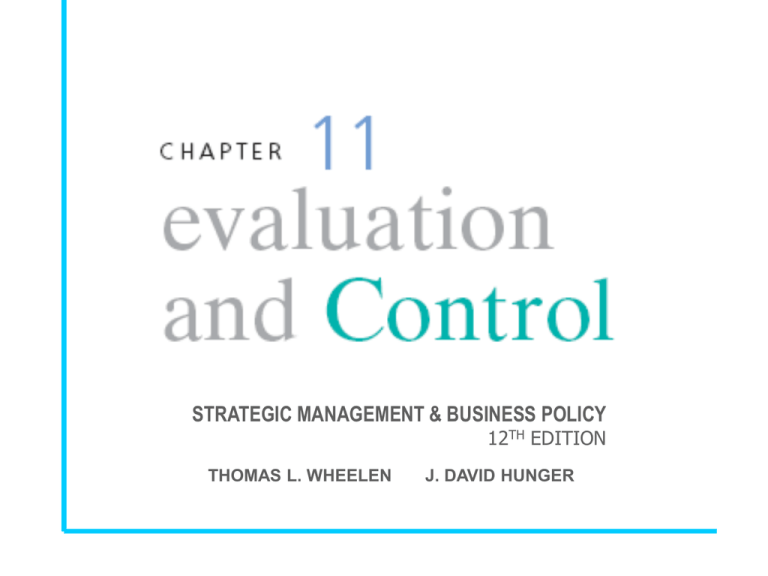STRATEGIC MANAGEMENT & BUSINESS POLICY 12 EDITION
advertisement

STRATEGIC MANAGEMENT & BUSINESS POLICY 12TH EDITION THOMAS L. WHEELEN J. DAVID HUNGER Evaluation and Control ensures that a company is achieving what it set out to accomplish by comparing performance with desired results and taking corrective action as needed Prentice Hall, Inc. ©2009 11-2 Prentice Hall, Inc. ©2009 11-3 Appropriate Measures Performance is the end result of activity Steering controls measure variables that influence • • • future profitability Cost per passenger mile (airlines) Inventory turnover ratio (retail) Customer satisfaction Prentice Hall, Inc. ©2009 11-4 Types of Controls • Output controls- specify what is to be accomplished by focusing on the end result • Behavior controls specify how something is done through policies, rules, standard operating procedures and orders from supervisors • Input controls emphasize resources Prentice Hall, Inc. ©2009 11-5 Activity Based Costing • Activity based costing- allocates indirect and direct costs to individual product lines based on valueadded activities going into that product – Allows accountants to charge costs more accurately since it allocates overhead more precisely Prentice Hall, Inc. ©2009 11-6 Primary Measures of Corporate Performance • • • • Return on Investment (ROI) Earnings per share (EPS) Return on equity (ROE) Operating cash flow Prentice Hall, Inc. ©2009 11-7 Shareholder Value- the present value of the anticipated future streams of cash flows from the business plus the value of the company if liquidated Economic Value Added (EVA)- measures the difference between the pre-strategy and poststrategy values for the business EVA=After tax income-total annual cost of capital Prentice Hall, Inc. ©2009 11-8 Market Value Added (MVA)- measures the difference between the market value of a corporation and the capital contributed by shareholders and lenders • Measures the stock market’s estimate of the net present value of a firm’s past and expected capital investment projects Prentice Hall, Inc. ©2009 11-9 Balanced score card– combines financial measures • • • • that tell results of actions already taken with operational measures on customer satisfaction, internal processes and the corporation’s innovation and improvement activities Financial Customer Internal business perspective Innovation and learning Prentice Hall, Inc. ©2009 11-10 • Lack of quantifiable objectives or performance standards • Inability to use information systems to provide timely and valid information Prentice Hall, Inc. ©2009 11-11 Short term orientation- managers only consider current tactical or operational issues and ignore long-term strategic issues • Lack of time • Do not recognize importance of long-term issues • Are not evaluated on a long-term basis Prentice Hall, Inc. ©2009 11-12 Goal Displacement- confusion of the means with ends • Behavior substitution- when people substitute activities that do not lead to goal accomplishment for activities that do lead to goal accomplishment because the wrong activities are rewarded • Suboptimization- when a unit optimizing its goal accomplishment is to the detriment of the organization as a whole Prentice Hall, Inc. ©2009 11-13 1. 2. 3. 4. 5. 6. Controls should involve only the minimum amount of information needed to give a reliable picture of events (80/20 Rule) Controls should monitor only meaningful activities and results, regardless of measurement difficulty Controls should be timely so that corrective action can be taken before it is too late Long-term and short-term goals should be used Controls should aim at pinpointing exceptions Emphasize the reward of meeting or exceeding standards rather than punishment for failing to meet standards Prentice Hall, Inc. ©2009 11-14




